Founded in 1938 and published semiannually by Sophia University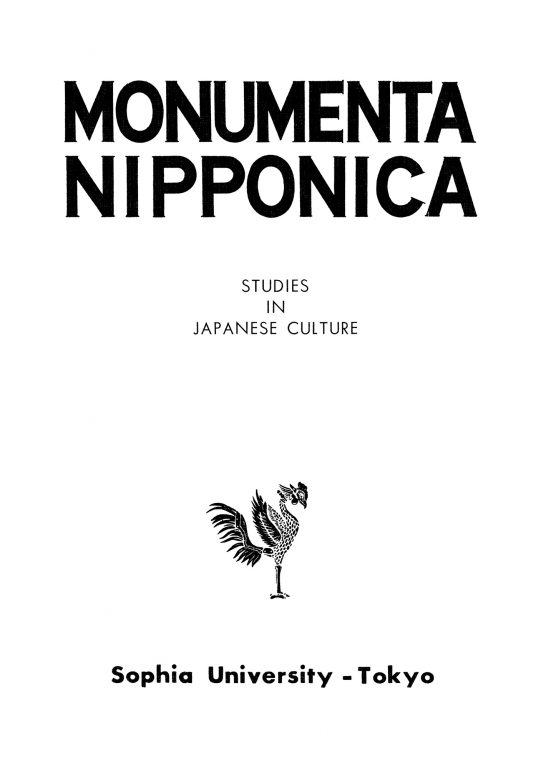 MN 8:1/2 (1952) 439–40Japan by Hugh BortonWilhelm Schiffer
MN 8:1/2 (1952) 439–40Japan by Hugh BortonWilhelm Schiffer MN 8:1/2 (1952) 452The Nō Plays of Japan by Arthur Waley, Oswald SickertWilhelm Schiffer
MN 8:1/2 (1952) 452The Nō Plays of Japan by Arthur Waley, Oswald SickertWilhelm Schiffer MN 8:1/2 (1952) 457–581. Abundance of All by Alfred Koehn; 2. Window Flowers by Alfred Koehn; 3. Letter Paintings by Alfred Koehn; 4. Japanese Classical Flower Arrangement by Alfred KoehnWilhelm Schiffer
MN 8:1/2 (1952) 457–581. Abundance of All by Alfred Koehn; 2. Window Flowers by Alfred Koehn; 3. Letter Paintings by Alfred Koehn; 4. Japanese Classical Flower Arrangement by Alfred KoehnWilhelm Schiffer MN 8:1/2 (1952) 462–64Tōyō Bunka (Oriental Culture) by Tōyō Gakkai at the Tōyō Bunka Kenkyūsho; Tōhōgaku (Eastern Studies) by Tōyō Gakkai (Institute of Eastern Culture)Wilhelm Schiffer
MN 8:1/2 (1952) 462–64Tōyō Bunka (Oriental Culture) by Tōyō Gakkai at the Tōyō Bunka Kenkyūsho; Tōhōgaku (Eastern Studies) by Tōyō Gakkai (Institute of Eastern Culture)Wilhelm Schiffer MN 8:1/2 (1952) 453–54Apostolic Legations to China of the Eighteenth Century by Antonio Sisto RossoWilhelm Schiffer
MN 8:1/2 (1952) 453–54Apostolic Legations to China of the Eighteenth Century by Antonio Sisto RossoWilhelm Schiffer MN 8:1/2 (1952) 452–53A History of China from the Earliest Times to the Present Day by Wolfram EberhardWilhelm Schiffer
MN 8:1/2 (1952) 452–53A History of China from the Earliest Times to the Present Day by Wolfram EberhardWilhelm Schiffer MN 7:1/2 (1951) 338–39The Meeting of East and West by F. S. C. NorthropWilhelm Schiffer
MN 7:1/2 (1951) 338–39The Meeting of East and West by F. S. C. NorthropWilhelm Schiffer MN 7:1/2 (1951) 363–65Itō Jinsai, A Philosopher, Educator and Sinologist of the Tokugawa Period by Joseph John SpaeWilhelm Schiffer
MN 7:1/2 (1951) 363–65Itō Jinsai, A Philosopher, Educator and Sinologist of the Tokugawa Period by Joseph John SpaeWilhelm Schiffer MN 7:1/2 (1951) 365Chugoku Kodai Seiji Shisō (Political Ideals in Ancient China) by Nakae UshikichiWilhelm Schiffer
MN 7:1/2 (1951) 365Chugoku Kodai Seiji Shisō (Political Ideals in Ancient China) by Nakae UshikichiWilhelm Schiffer MN 7:1/2 (1951) 366Zen in English Literature and Oriental Classics by R. H. BlythWilhelm Schiffer
MN 7:1/2 (1951) 366Zen in English Literature and Oriental Classics by R. H. BlythWilhelm Schiffer MN 7:1/2 (1951) 368–771. Complete Course of Japanese Conversation-Grammar. A new and practical method of learning the Japanese language by Mr. Oreste Vaccari, Mrs. Oreste Vaccari; 2. Japanese Readers. Complete in one volume by Mr. Oreste Vaccari, Mrs. Oreste Vaccari; 3. Pictorial Chinese-Japanese Characters. A new and fascinating method to learn ideographs by Mr. Oreste Vaccari, Mrs. Oreste Vaccari; 4. Standard Kanji. An easy method to learn the 1850 Chinese-Japanese characters prescribed by the Ministery of Education of Japan for use in newspapers and magazines with seven thousand compound character-words used in everyday literature by Mr. Oreste Vaccari, Mrs. Oreste Vaccari; 5. A. B. C. Japanese-English Dictionary by Mr. Oreste Vaccari, Mrs. Oreste VaccariHans Müller, Max v. Küenburg and Wilhelm Schiffer
MN 7:1/2 (1951) 368–771. Complete Course of Japanese Conversation-Grammar. A new and practical method of learning the Japanese language by Mr. Oreste Vaccari, Mrs. Oreste Vaccari; 2. Japanese Readers. Complete in one volume by Mr. Oreste Vaccari, Mrs. Oreste Vaccari; 3. Pictorial Chinese-Japanese Characters. A new and fascinating method to learn ideographs by Mr. Oreste Vaccari, Mrs. Oreste Vaccari; 4. Standard Kanji. An easy method to learn the 1850 Chinese-Japanese characters prescribed by the Ministery of Education of Japan for use in newspapers and magazines with seven thousand compound character-words used in everyday literature by Mr. Oreste Vaccari, Mrs. Oreste Vaccari; 5. A. B. C. Japanese-English Dictionary by Mr. Oreste Vaccari, Mrs. Oreste VaccariHans Müller, Max v. Küenburg and Wilhelm Schiffer MN 7:1/2 (1951) 366–67Kanji no Kigen (The Origin of Chinese Characters) by Jōken KatōWilhelm Schiffer
MN 7:1/2 (1951) 366–67Kanji no Kigen (The Origin of Chinese Characters) by Jōken KatōWilhelm Schiffer MN 7:1/2 (1951) 365–66Jukyō no Kenkyū (Studies on Confucianism) by Tsuda SōkichiWilhelm Schiffer
MN 7:1/2 (1951) 365–66Jukyō no Kenkyū (Studies on Confucianism) by Tsuda SōkichiWilhelm Schiffer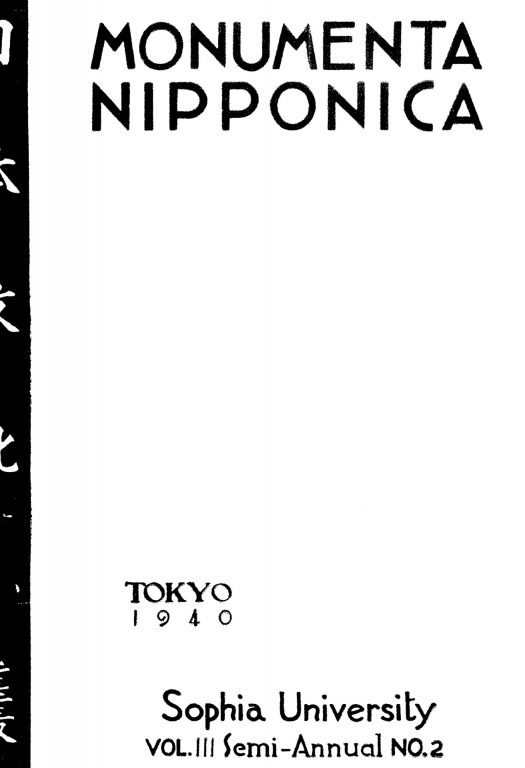 MN 3:2 (1940) 676–678Kōshi-Kyō Taigi by Hattori UnokichiWilhelm Schiffer
MN 3:2 (1940) 676–678Kōshi-Kyō Taigi by Hattori UnokichiWilhelm Schiffer MN 3:2 (1940) 690Tōho Gakuhō (Zeitschrift für östliche Studien) by Herausgegeben vom Tōhō Bunka KenkyūshoWilhelm Schiffer
MN 3:2 (1940) 690Tōho Gakuhō (Zeitschrift für östliche Studien) by Herausgegeben vom Tōhō Bunka KenkyūshoWilhelm Schiffer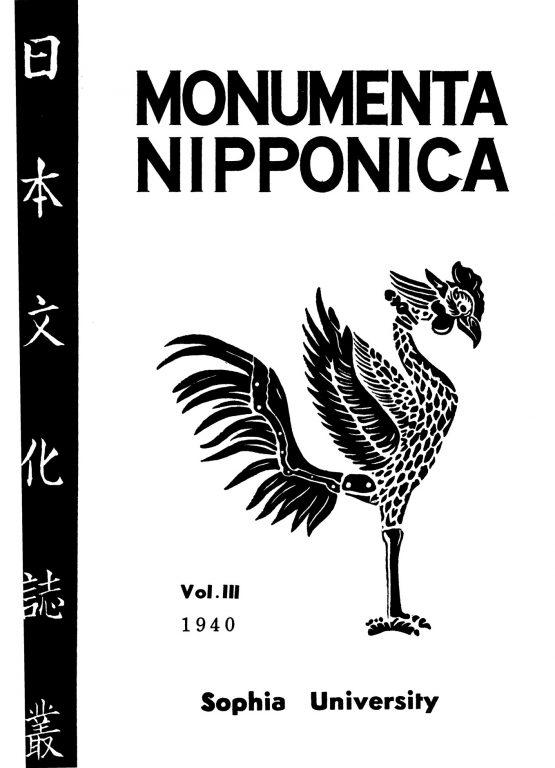 MN 3:1 (1940) 281–90Gokai und GojōWilhelm Schiffer
MN 3:1 (1940) 281–90Gokai und GojōWilhelm Schiffer MN 3:1 (1940) 331Bushidō Hōten (Handbuch des Bushidō) by Saeki Ariyoshi, Inoue TetsujirōWilhelm Schiffer
MN 3:1 (1940) 331Bushidō Hōten (Handbuch des Bushidō) by Saeki Ariyoshi, Inoue TetsujirōWilhelm Schiffer MN 3:1 (1940) 335–36Tōhō Gakuhō (Zeitschrift für östliche Studien)Wilhelm Schiffer
MN 3:1 (1940) 335–36Tōhō Gakuhō (Zeitschrift für östliche Studien)Wilhelm Schiffer MN 3:1 (1940) 336–38Zaidan Hōjin Meiji Seitoku Kinen Gakkai Kiyō (Berichte der Zaidan Hōjin Meiji Seitoku Kinen Gakkai)Wilhelm Schiffer
MN 3:1 (1940) 336–38Zaidan Hōjin Meiji Seitoku Kinen Gakkai Kiyō (Berichte der Zaidan Hōjin Meiji Seitoku Kinen Gakkai)Wilhelm Schiffer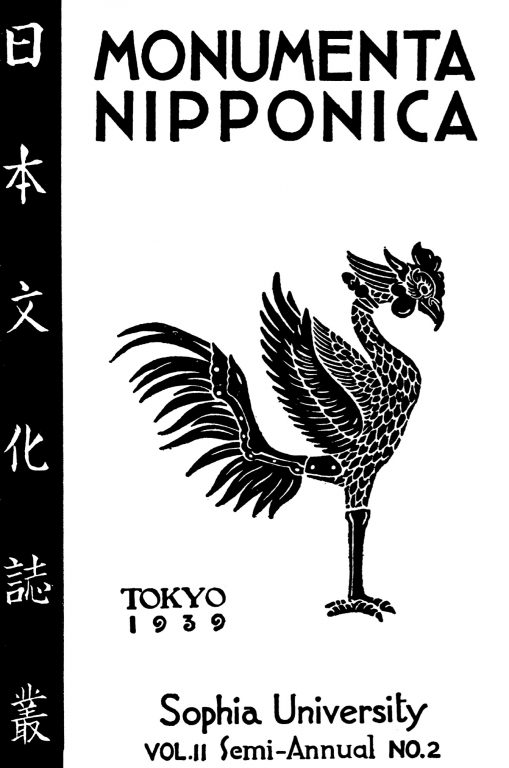 MN 2:2 (1939) 642–643Tōhō Gakuhō (Zeitschrift für östliche Studien) by Toho Bunka KenkyushoWilhelm Schiffer
MN 2:2 (1939) 642–643Tōhō Gakuhō (Zeitschrift für östliche Studien) by Toho Bunka KenkyushoWilhelm Schiffer MN 2:2 (1939) 654Shu-Eki Jū-Yoku Seigi (Ein Kommentar zu den zehn Flügeln des Chou-i) by Kitamura SawakichiWilhelm Schiffer
MN 2:2 (1939) 654Shu-Eki Jū-Yoku Seigi (Ein Kommentar zu den zehn Flügeln des Chou-i) by Kitamura SawakichiWilhelm Schiffer MN 2:2 (1939) 655–656Japan. Ein Kulturüberblick by Ryuichi KajiWilhelm Schiffer
MN 2:2 (1939) 655–656Japan. Ein Kulturüberblick by Ryuichi KajiWilhelm Schiffer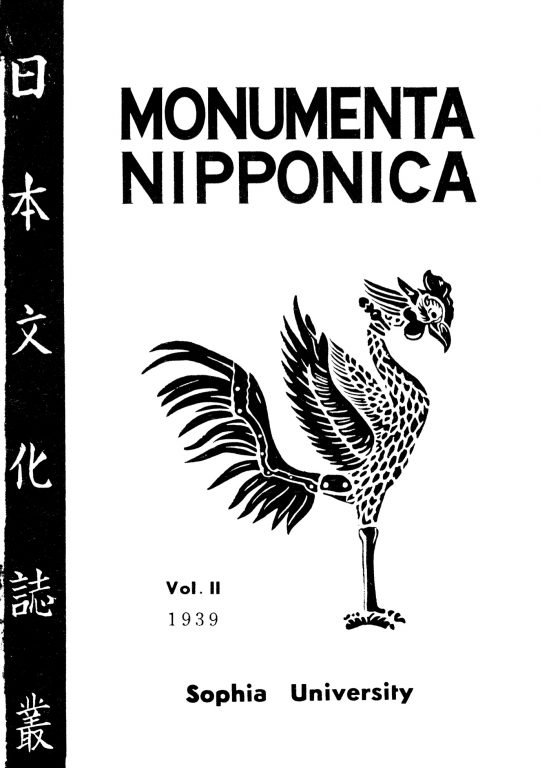 MN 2:1 (1939) 140–64Die Entwicklung der Kokugaku. Dargestellt in ihren HauptvertreternHans Stolte, Heinrich Dumoulin and Wilhelm Schiffer
MN 2:1 (1939) 140–64Die Entwicklung der Kokugaku. Dargestellt in ihren HauptvertreternHans Stolte, Heinrich Dumoulin and Wilhelm Schiffer MN 2:1 (1939) 212–36Hirata Atsutane: Taidō Wakumon. Es fragte einer nach dem Grossen Weg…Hirata Atsutane, Translated by Wilhelm Schiffer
MN 2:1 (1939) 212–36Hirata Atsutane: Taidō Wakumon. Es fragte einer nach dem Grossen Weg…Hirata Atsutane, Translated by Wilhelm Schiffer MN 2:1 (1939) 320–22Grundriss der Ju-Lehre by Kitamura SawakichiWilhelm Schiffer
MN 2:1 (1939) 320–22Grundriss der Ju-Lehre by Kitamura SawakichiWilhelm Schiffer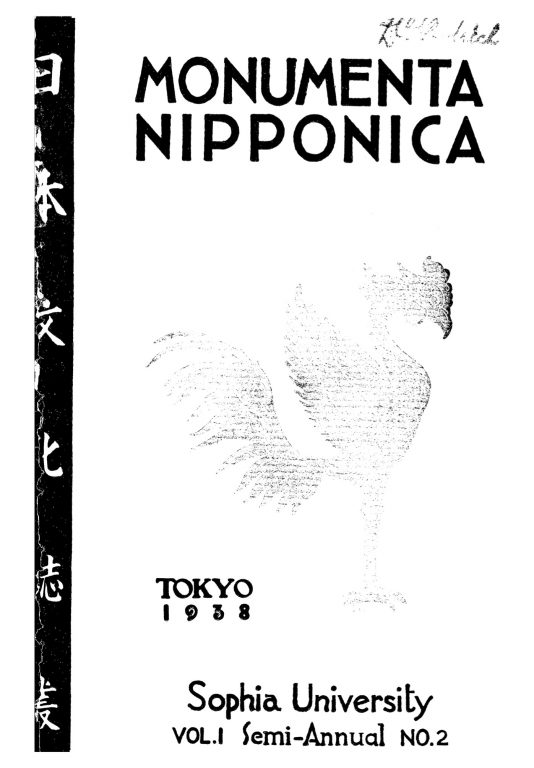 MN 1:2 (1938) 622A Course of Colloquial Chinese, Book I by S. N. Usoff, C. TyrwhittWilhelm Schiffer
MN 1:2 (1938) 622A Course of Colloquial Chinese, Book I by S. N. Usoff, C. TyrwhittWilhelm Schiffer






